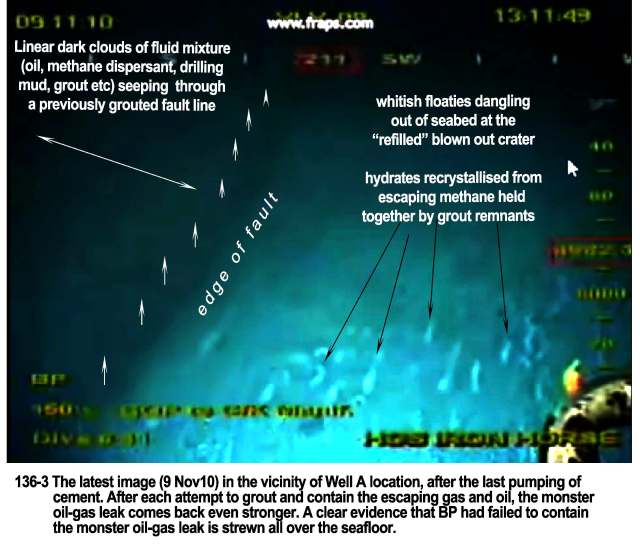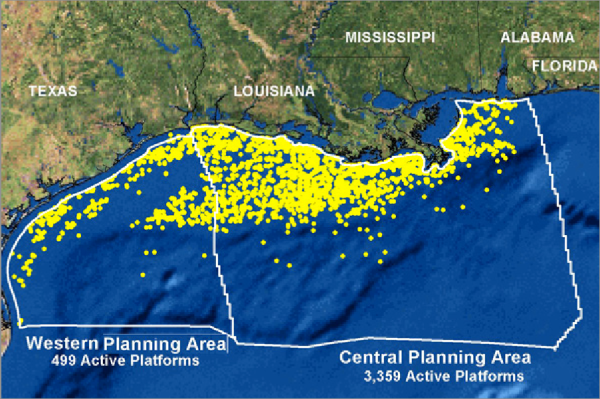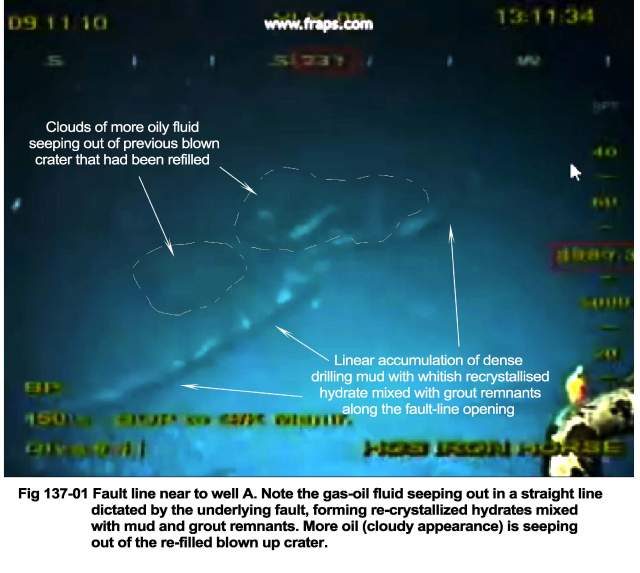The Gulf of Mexico is Dying
A Special Report on the BP Gulf Oil Spill

It is with deep regret that we publish this report. We do not take this responsibility lightly, as the consequences of the following observations are of such great import and have such far-reaching ramifications for the entire planet. Truly, the fate of the oceans of the world hangs in the balance, as does the future of humankind.
The Gulf of Mexico (GOM) does not exist in isolation and is, in fact, connected to the Seven Seas. Hence, we publish these findings in order that the world community will come together to further contemplate this dire and demanding predicament. We also do so with the hope that an appropriate global response will be formulated, and acted upon, for the sake of future generations. It is the most basic responsibility for every civilization to leave their world in a better condition than that which they inherited from their forbears.
After conducting the Gulf Oil Spill Remediation Conference for over seven months, we can now disseminate the following information with the authority and confidence of those who have thoroughly investigated a crime scene. There are many research articles, investigative reports and penetrating exposes archived at the following website. Particularly those posted from August through November provide a unique body of evidence, many with compelling photo-documentaries, which portray the true state of affairs at the Macondo Prospect in the GOM.
http://phoenixrisingfromthegulf.wordpress.com/

The pictorial evidence tells the whole story.
Especially that the BP narrative is nothing but a corporate-created illusion – a web of fabrication spun in collaboration with the US Federal Government and Mainstream Media. Big Oil, as well as the Military-Industrial Complex, have aided and abetted this whole scheme and info blackout because the very future of the Oil & Gas Industry is at stake, as is the future of the US Empire which sprawls around the world and requires vast amounts of hydrocarbon fuel.
Should the truth seep out and into the mass consciousness – that the GOM is slowly but surely filling up with oil and gas – certainly many would rightly question the integrity, and sanity, of the whole venture, as well as the entire industry itself. And then perhaps the process would begin of transitioning the planet away from the hydrocarbon fuel paradigm altogether.

It’s not a pretty picture.
The various pictures, photos and diagrams that fill the many articles at the aforementioned website represent photo-evidence about the true state of affairs on the seafloor surrounding the Macondo Prospect in the Mississippi Canyon, which is located in the Central Planning Area of the northern Gulf of Mexico. The very dynamics of the dramatic changes and continuous evolution of the seafloor have been captured in ways that very few have ever seen. These snapshots have given us a window of understanding into the true state of the underlying geological formations around the various wells drilled in the Macondo Prospect.
Although our many deductions may be difficult for the layperson to apprehend at first, to the trained eye these are but obvious conclusions which are simply the result of cause and effect. In other words there is no dispute around the most serious geological changes which have occurred, and continue to occur, in the region around the Macondo wells. The original predicament (an 87 day gushing well) was extremely serious, as grasped by the entire world, and the existing situation is only going to get progressively worse.
So, just what does this current picture look like. Please click on the link below to view the relevant diagrams and read the commentary:

As the diagrams clearly indicate, the geology around the well bore has been blown. This occurred because of drilling contiguous to a salt dome(1), as well as because of the gas explosions which did much damage to the integrity of the well casing, cementing, well bore, well head, and foundation around the well head. Eighty-seven straight days of gushing hydrocarbon effluent under great pressure only served to further undermine the entire well system. Finally, when it was capped, putting the system back under pressure forced the upsurging hydrocarbons to find weaknesses throughout the greater system, which revealed all sorts of compromised, fractured and unsettled geology through which the hydrocarbons could travel all the way to the seafloor and into the GOM.
(1)“The rock beds in the vicinity of a salt dome are highly fractured and permeable due to stress and deformation which occur as the salt dome thrusted upwards.” (Per BK Lim, Geohazards Specialist)
We also have faults* to deal with in this scenario of which there are both deep and shallow. Depending on the current vital stats of the blown out well, especially its actual depth; the number, location and severity of the breaches throughout the well system; the pressure at the wellhead; as well as the type and status of geological formations/strata it has been drilled into, these faults will become prominently configured into the future stability of the whole region. Larger faults can open up much greater opportunities for the hydrocarbons to find their way to the seafloor via cracks and crevices, craters and chasms. In fact the numerous leaks and seeps throughout the seafloor surface, which are quite apparent from various ROV live-feeds, give testimony to sub-seafloor geological formations in great turmoil and undergoing unprecedented flux.
*“Once the oil gets into the shallow faulted zones, we have an uncontrollable situation. The place where most of the oil and gas is coming out is at the foot hills of the continental shelf as shown in figure 134-1 in the article “BP continues to dazzle us with their unlimited magic”. The discovery by WHOI of the 22 mile long river of oil originated from these leaks. So the leaks will be mainly along the faults where I have marked (shallow) in “What is going on at West Sirius” and deep strike-slip faults (red line) on fig 134-1.” (Per BK Lim, Geohazards Specialist)
Just how bad is this situation?
There are actually three different ongoing disasters – each more grave and challenging than the previous one – which must be considered when assessing the awesome destruction to the GOM by the Oil & Gas Industry.
I. A single gushing well at 7o – 100,000 barrels per day of hydrocarbon effluent for 87 days into the GOM at the Macondo Prospect along with two smaller rogue wells
II. Numerous leaks and seeps within five to ten square miles of the Macondo well with an aggregate outflow of an unknown amount of hydrocarbon effluent per day into the GOM
III. Countless gushers and spills, leaks and seeps, throughout the Gulf of Mexico, where drilling has been conducted for many decades, with an aggregate outflow that can not even be estimated, but is well in excess of any guesstimate which would ensure the slow and steady demise of the GOM.

It is the last scenario which we all face and to which there is no easy or obvious solution. The truth be told, there currently does not exist the technology or machinery or equipment to repair the damage that has been wrought by the process of deep undersea drilling, especially when it is performed in the wrong place. Therefore, wherever the oil and gas find points of entry into the GOM through the seafloor, these leaks and seeps will only continue to get worse. Here’s why:
Methane gas mixed with saltwater and mud makes for a very potent corrosive agent. Under high pressure it will find every point of egress through the rock and sediment formations all the way up to the seafloor where it will find any point of exit that is available. The longer and more forcefully that it flows throughout the fractured area, which is dependent on the volume, temperature and pressure at the source of the hydrocarbons, the more its corrosive effects will widen, broaden and enlarge the channels, cracks and crevices throughout the sub-seafloor geology, thereby creating a predicament that no science, technology or equipment can remedy.
Dire realities of the methane hydrate predicament
The Macondo Prospect in the GOM is just one of many throughout the oceans of the world where the seafloor has beds of methane hydrate locked in place by very high pressure and low temperatures. Likewise, there are myriad repositories and large “reservoirs” of methane clathrates in the sub-seafloor strata, and especially within the more superficial geological formations, which are being greatly impacted by all oil and gas drilling and extraction activities. It does not take much imagination to understand how the upsurging hydrocarbons (very hot oil and gas) are quickly converting the frozen hydrates to gas, thereby causing innumerable “micro-displacements”, the cumulative effect of which will translate to larger “macro-displacements” of rock, sediment and other geological formations.
When you factor in this constant vaporization of methane hydrates/clathrates both sub-seafloor as well as those scattered around the seafloor surface to the existing scenario, this devolving situation becomes that much more difficult to effectively remedy. With the resulting shifts and resettling and reconfiguration of the entire seafloor terrain and underlying strata occurring in the wake of these dynamics, we are left with a situation that is not going to get better through the use of even more invasive technology and intrusive machinery.
Question: How many times can you grout a seafloor crack that was caused by an underlying superficial fault after drilling into an old mud volcano?
Answer: “In the attempt to seal the oil from oozing through the faults, BP resorted to high pressure grouting. Basically it is like cementing the cracks in the rock by injecting grout (cement mixture) at high pressure. The way they do this is by drilling an injection hole into the shallow rocks and pumping in the grout. The grout in “slurry” state will permeate into the cracks, cure and seal up the cracks. However it is not working because of the presence of gas and oil. It is like super-glue. You need to clean the surfaces before you apply the glue; otherwise it won’t stick and will come off eventually after a few days or weeks. That is why we can see a few blown out craters – shown in my article – Is the last rite for the Macondo Well for real?” (Per BK Lim, Geohazards Specialist)
Likewise, how do you fill a newly emerging gash in the seafloor which is caused by a deep fault due to low level seismic activity, or worse, a full blown earthquake?!
Seismic activity in the GOM and the uptick in earthquakes in the Mississippi River Basin and surrounding region

The oil and gas platforms that were in operation throughout the northern Gulf of Mexico in 2006 (per Wikipedia).
We now come to the most serious issue regarding the relentless drilling for oil and gas throughout the Gulf of Mexico. The map above clearly illustrates the density of drilling throughout the northern GOM as of 2006. Likewise, the map below demonstrates the extraordinary and increasing intensity of these very same operations off the coast of Louisiana alone.

Green lines represent active pipes (25,000 miles in all). Yellow dots represent oil rigs.
The map that follows, however, tells a story which demands the attention of every resident of the GOM coastline. The video link below the map shows the development timeline of the successively deeper wells being drilled during the last decade. Of course, with greater depths come much greater risks, as the technology and machinery have not been proportionately upgraded to accommodate the extraordinary demands and unforeseen contingencies of such a speculative and dangerous enterprise*.
*Oil and gas drilling in seawater depths of over 4000 feet, and through 15,000 to 25,000 feet of the earth’s crust and mantle, is considered extremely dangerous to those from whom reason and common sense have not yet fled.
http://www.youtube.com/watch?v=bh_wNVUx9SI
It’s critical to understand the location and current activity of the various faults which exist throughout the GOM and how they connect to the New Madrid Fault Line, as well as other major faults at much greater distance. There does appear to be a emerging uptick in earthquake activity in the greater Louisiana area, as well as contiguous regions in the GOM as demonstrated by unprecedented, albeit low level earthquakes. Correlations between these earthquakes/seismic activity and major operations at the Macondo Prospect have been alluded to in our previous postings.
Earthquake Activity in Gulf of Mexico Prompts 2003 Study for MMS
Gulf of Mexico Subsea Structures May Be in Seismic Danger Zone – Part 2
Now then, the question remains just how vulnerable has the GOM been made to a truly catastrophic event, ending up with an overwhelming displacement of water producing tidal waves, in the aftermath of an undersea earthquake.
There is no question that the ceaseless fracturing of the seafloor and fissuring of the sub-seafloor geological strata by the Oil & Gas Industry has set up a quite conducive environment for HUGE unintended consequences. We leave it up to the experts to conduct the necessary risk assessments, which will most assuredly let loose a sea of red flags about what Big Oil has done, and is currently doing, in the Gulf of Mexico. Furthermore, we are deeply concerned that, if a permanent moratorium on all new oil and gas drilling and extraction in the GOM is not put into place poste haste, the coastal communities will remain in a very precarious situation.
Worsening GOM predicament is reflective of the status quo around the globe
Now consider the following scenario: that this very same predicament, which we have all witnessed in the Gulf of Mexico, is happening wherever oil and gas drilling is conducted in the various water bodies throughout the planet. Therefore we can multiply the Macondo Prospect disaster a hundred times and still not come close to the impacts that these ongoing gushers and spills, leaks and seeps are having the world over.
Perhaps the BP Gulf Oil Spill was the defining moment in modern history when all the nations of the world community were called by Mother Earth herself to begin transitioning the planet away from the Hydrocarbon Fuel Paradigm. After all, we may never get another chance!
Tom Termotto is National Coordinator of the Gulf Oil Spill Remediation Conference
[email protected]
SKYPE: Gulf_Advocate
http://oilspillsolutionsnow.org/



